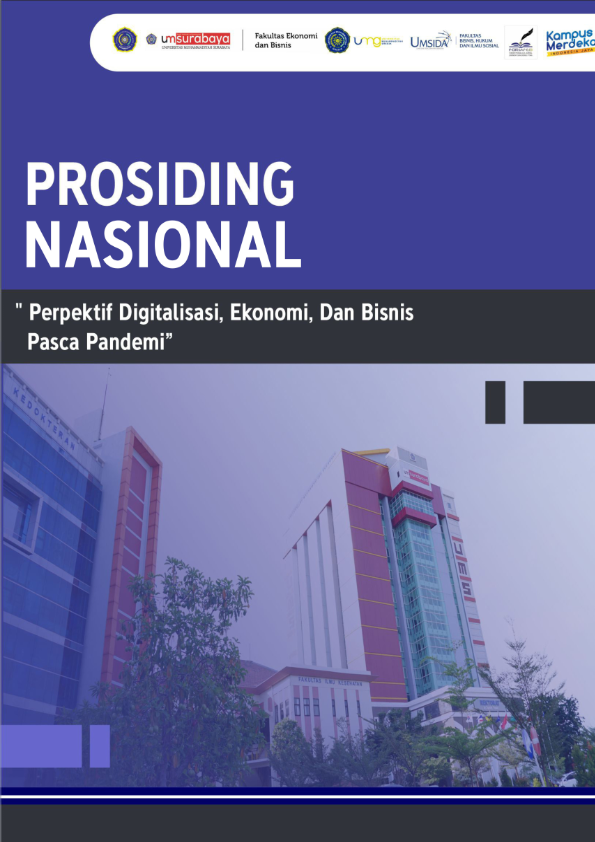ANALISIS FAKTOR – FAKTOR YANG MEMPERNGARUHI MINAT BERTRANSAKSI MENGGUNAKAN E-COMMERCE
Abstrak
As a growing transaction dealer, E-commerce has many risks and uncertainties compared to conventional transactions, but e-commerce users continue to increase. For this reason, the purpose of this study is to find out what is behind a person's interest in transacting using e-commerce. This research method uses quantitative methods with multiple linear regression analysis techniques. The sample of this research is accounting student of Muhammadiyah University of Gresik. The results showed that the variables of convenience, subjective norms, and knowledge of AIS had an effect on the interest in transacting using e-commerce, while the security variables and risk perception had no effect on the interest in transacting using e-commerce. From the results of this study, recommendations for further research are expected to be able to add new variables, not only using the questionnaire method and can expand the population.
Keywords: Convenience; Interests in Transactions Using E-Commerce; Knowledge of SIA; Perceptions of Risk;Â Security; Subjective Norms
Referensi
Ajzen, I. (1985). From intentions to actions: A theory of planned behavior. In Action control (pp. 11–39). Springer.
Amalia, Z. N., & Suyono, N. A. (2015). Faktor Minat Perilaku Bertransaksi Menggunakan E- Commerce. Wonosobo: Universitas Sains Al Qur’an.
Bodnar, G. H., & Hopwood, W. S. (2003). Sistem Informasi Akuntansi, Edisi Indonesia. Jakarta: PT Indeks Kelompok Gramedia.
Budiastuti, A. D. P., & Muid, D. (2020). Analisis Faktor-Faktor Pengaruh Minat Penggunaan Pada Aplikasi Shopee Dengan Menggunakan Technology Acceptance Model ( TAM ). Diponegoro Journal of Accounting, 9, 1–10.
Cheung, R., & Vogel, D. (2013). Predicting user acceptance of collaborative technologies: An extension of the technology acceptance model for e-learning. Computers & Education, 63, 160–175.
Davis, F. D. (1989). Perceived usefulness, perceived ease of use, and user acceptance of information technology. MIS Quarterly, 319–340.
Dolatabadi, H. R., & Ebrahimi, H. (2010). Factors influencing iranian consumer’s trust in internet shopping. European Journal of Social Sciences, 16(2), 307–318.
Ghozali, I. (2013). Aplikasi Analisis Multivariate Dengan Program IBM dan SPSS 21. In Aplikasi Analisis Multivariate dengan Pogram iIBM SPSS 21. https://doi.org/10.1126/science.1158668
Indriantoro, N., & Supomo, B. (2016). Metodologi Penelitian Bisnis Untuk Akuntansi & Manajemen. In Yogyakarta : Penerbit BPFE.
Jackson, C. M., Chow, S., & Leitch, R. A. (1997). Toward an understanding of the behavioral intention to use an information system. Decision Sciences, 28(2), 357–389.
Jayani, D. H. (2019). Tren Pengguna E-Commerce Terus Tumbuh. Retrieved October 10, 2019, from 2019 website: https://databoks.katadata.co.id/datapublish/2019/10/10/tren-pengguna-e-commerce-2017-2023
Jogiyanto, H. M. (n.d.). Analisis & Desain Sistem Informasi: Pendekatan Terstruktur Teori dan Praktik Aplikasi Bisnis, 2005. Andi Offset, Yogyakarta.
Krismiaji, D., & Sc, M. (n.d.). Akt. 2010. Sistem Informasi Akuntansi. Yogyakarta: Unit. Penerbit dan Percetakan Sekolah Tinggi Ilmu YKPN.
Mataram, K. (n.d.). Analisis Pemeringkatan Kinerja Dengan Perspektif Balanced Determinan Busniess To Consumer (B2c) E-Commerce. Jurnal Riset Akuntansi Aksioma, 16(2).
Notoatmodjo, S. (2010). Ilmu perilaku kesehatan. Jakarta : PT Rinneka Cipta.
Paul, P. J., & Olson, J. C. (2013). Perilaku konsumen dan strategi pemasaran. Jakarta: Salemba Empat.
Pavlou, P. A. (2003). Consumer acceptance of electronic commerce: Integrating trust and risk with the technology acceptance model. International Journal of Electronic Commerce, 7(3), 101–134.
Raman, A., & Annamalai, V. (2011). Web services and e-shopping decisions: A study on malaysian e-consumer. Wireless Information Networks & Business Information System, 2(5), 54–60.
Romney, M., Steinbart, P., Mula, J., McNamara, R., & Tonkin, T. (2012). Accounting Information Systems Australasian Edition. Pearson Higher Education AU.
Saraswati, P., & Baridwan, Z. (2013). Abstract : Acceptance E-Commerce System : Effect Trust , Perceived Risk And Perceived Benefit . This study. Jurnal Ilmiah Mahasiswa FEB Brawijaya, 1(2), 1–19.
Shabrina, N. R., Indriasari, R., & Mapparessa, N. (n.d.). Pengaruh Kepercayaan Dan Keamanan Terhadap Niat Untuk Bertransaksi Menggunakan Sistem E-Commerce (Studi Kasus pada Mahasiswa Program Studi S1 Akuntansi Fakultas Ekonomi dan Bisnis Universitas Tadulako). Jurnal Akun Nabelo: Jurnal Akuntansi Netral, Akuntabel, Objektif, 2(2), 232–241.
Slameto, (2003), Belajar & faktor yang Mempengaruhinya. Jakarta : PT Rineka Cipta.
Sugiyono, S. (2010). Metode Penelitian Kuantitatif Dan Kualitatif Dan R&D. Alfabeta Bandung.
Tugiso, I., Haryono, A. T., & Minarsih, M. M. (2016). Pengaruh relationship marketing, Keamanan, kepercayaan dan kualitas pelayanan terhadap keputusan pembelian online shop dan loyalitas konsumen sebagai variabel intervening studi kasus pada onlineshop “Numira†Semarang. Journal of Management, 2(2), 1–18. Retrieved from https://jurnal.unpand.ac.id/index.php/MS/article/view/558/543
Tumpal Manik. (2018). Analisis Peranan Sistem Informasi Akuntansi Dalam E-Commerces Terhadap Pengendalian Bisnis Online. Jurnal Ilmiah Akuntansi Dan Finansial Indonesia, 1(2), 51–64. https://doi.org/10.31629/jiafi.v1i2.1244
Wardhana, O. H. P. (2016). Pengaruh Persepsi Kemudahan, Persepsi Kegunaan, Persepsi Nilai, Pengaruh Sosial, Persepsi Risiko, dan Kepercayaan Terhadap Minat Menggunakan E-commerce. Jurnal Ilmiah Mahasiswa FEB, 4(2).
Yutadi, K. (2014). Pengaruh Persepsi Privasi, Persepsi Keamanan, Persepsi Kepercayaan, Persepsi Risiko, Persepsi Kegunaan Dan Persepsi Kemudahan Penggunaan Terhadap Minat Penggunaan E-commerce. Universitas Brawijaya. Jurnal Ilmiyah Mahasiswa FEB, 3(1), 1-2.






